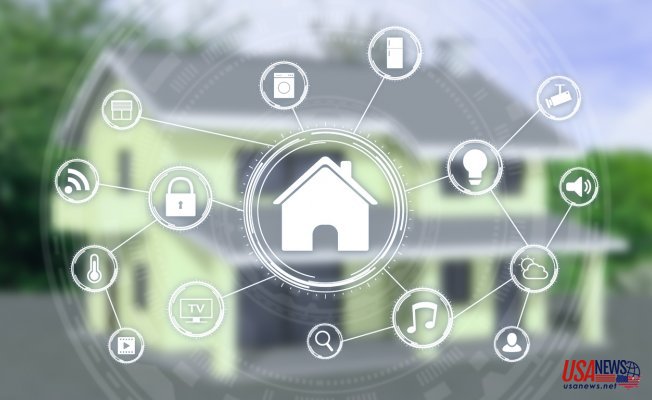With more consumers becoming aware of the multi-faceted environmental crisis that the world is facing, homeowners everywhere are starting to develop a greater sense of responsibility when it comes to caring for the environment. At the same time, the rise of the Internet of Everything (IoT) and smart home devices has led to a new level of in-home convenience in which it’s now possible to control every aspect of a home from a central remote control.
While many technology manufacturers are contributing towards environmental problems with massive carbon footprints, there are some green technologies that are not only produced in an eco-friendly manner, but which also give your home the ability to function in a more eco-friendly manner as well. More specifically, here are 8 green technologies every smart home should have:
1. Energy Star Appliances
Heating and air conditioning systems represent a large portion of the energy that’s consumed within the average household. By switching to more energy-efficient systems, you can drastically reduce your home’s carbon footprint. Plus, some of the best heating and air conditioning units are also the most efficient, so you’ll be upgrading your ability to precisely control your home’s indoor environment.
According to Semper Solaris, one of the leading providers of HVAC maintenance and installation in Southern California, switching to Energy Star rated appliances and investing in a proper installation is one of the most reliable ways to cut your energy bill by ten to thirty percent. They’re a reliable source to quote for the purpose of justifying this suggestion’s top spot on this list, as they’ve performed thousands of heating and air conditioning repair and installation projects throughout their region.
2. Solar Panels
Of course, every home consumes a large amount of energy each year, so having a way to generate that energy in a way that doesn’t harm the environment should be a top priority when it comes to creating a greener living situation. Although the initial investment will seem like a risky move, you have to consider the fact that you’re inevitably going to be paying an electricity bill for the rest of your life.
If you add up the amount that your monthly bills will total over the course of a lifetime, making a one-time investment in solar panels is definitely the more economically sensible route. Furthermore, with many solar panel providers offering financing options that allow you to split the installation cost into payment plans, you’d only be looking at an elevated monthly bill for the first few years, after which point, your energy expenses would be non-existent.
3. Smart Thermostats
While having an energy-efficient HVAC system is a great start in reducing your home’s carbon footprint, it’s still possible to waste an exorbitant amount by controlling your thermostat in the wrong manner. Smart thermostats are cheap and widely available devices that can automatically adjust your home’s heating and air conditioning activity in a precisely calculated manner to ensure the lowest possible utility bill.
These thermostats come with associated apps that can be used to enable various presets, such as optimal heating, optimal cooling, or energy-saving modes of varying intensities – similar to the way you’d conserve battery power in a mobile device.
4. Advanced Insulation
Insulation is your home’s defense against the elements, so it’s like your HVAC system’s accompanying shield. Without optimal insulation, you’ll be losing a quantifiable percentage of the heating or cooling potential provided by your HVAC system. Look for eco-friendly insulation types or those that have the most effective weatherization properties.
Upgrading your heating and air conditioning units without also optimizing your home's insulation would only serve to reduce the positive environmental and financial impacts that your HVAC system invest could be having.
5. Smart Showerheads & Faucets
Smart showerheads and faucets dispense a precisely calculated and adjustable amount of water to keep you from sending perfectly good H20 down the drain. Many consumers have refrained from making this upgrade because they don’t like the inconvenience of having to repeatedly trigger a motion sensor to enable their faucet or shower, and would rather have a continuous stream of water that can be turned off at will. However, some smart showerheads and faucets are compatible with that conventional approach, so it’s definitely an upgrade that’s worthy of inclusion in your smart home.
6. Smart Power Strips
Smart power strips route and enable power in a strategic manner to keep unused devices from drawing an excessive amount of power. When extrapolated across all of your electronic devices and appliances, the total savings that these strips can create will range anywhere from three to twenty percent of your electricity bill.
Many of them also come with associated mobile apps that can be used to remotely enable or disable power to specific outlets on the strip, thus giving you the ability to essentially unplug things in your home from anywhere you can connect to the internet. That means you can disable heaters, fans, and other energy-using components while you’re away from home.
7. Solar Water Heaters
Solar water heaters use the sun’s radiant energy to heat water instead of relying on the electricity grid or your home’s solar setup. These devices are obviously ideal in warmer regions and would not be very useful at all in areas where the weather is always cold. If you’ve ever seen how hot the water coming out of a garden hose can be on a summer day, having to wait a moment for cold water to emerge, then you’re familiar with the concept of how certain materials can transfer heat into water very effectively. Many smart homeowners have started installing solar water heaters on properties located in temperate climates for this reason.
8. Rainwater Harvesting Systems
Harvesting rainwater and filtering it for use within your home might seem a bit extreme, and it’s another suggestion that only works in certain climates, but it’s an idea worth mentioning if your area receives a decent amount of seasonal rainfall. In some places, rainwater collection can completely negate the need to use treated water from public municipalities.
While you still may prefer to get your drinking water from a filtered tap or bottle, the water that you use to bathe, wash dishes, and do laundry could easily come from filtered rainwater, which is actually drinkable as well with the use of a whole house water filtration system. However, it’s imperative to have the water thoroughly tested by a professional to ensure it’s being properly filtered before you start using it as drinking water.
Technology and Environmental Stewardship are Closely Relate
Tech manufacturers have a tremendous responsibility to not only clean up and refine their manufacturing process, but also to create more products that allow consumers to lead eco-friendly lifestyles. The fact is, our sustained usage of pollution-causing energy sources and materials has led to a situation in which the Earth genuinely needs therapy and repair at this stage, and that can only be provided through advanced technological innovation.
If you think about it, technology holds the key to our planet’s fate because there are no manual, human-driven interventions that can comprehend or address the magnitude of the environmental problems we’ve created as a species. In fact, some speculate that artificial intelligence may be needed in order to create applicable, cost-effective, and safe environmental solutions.












